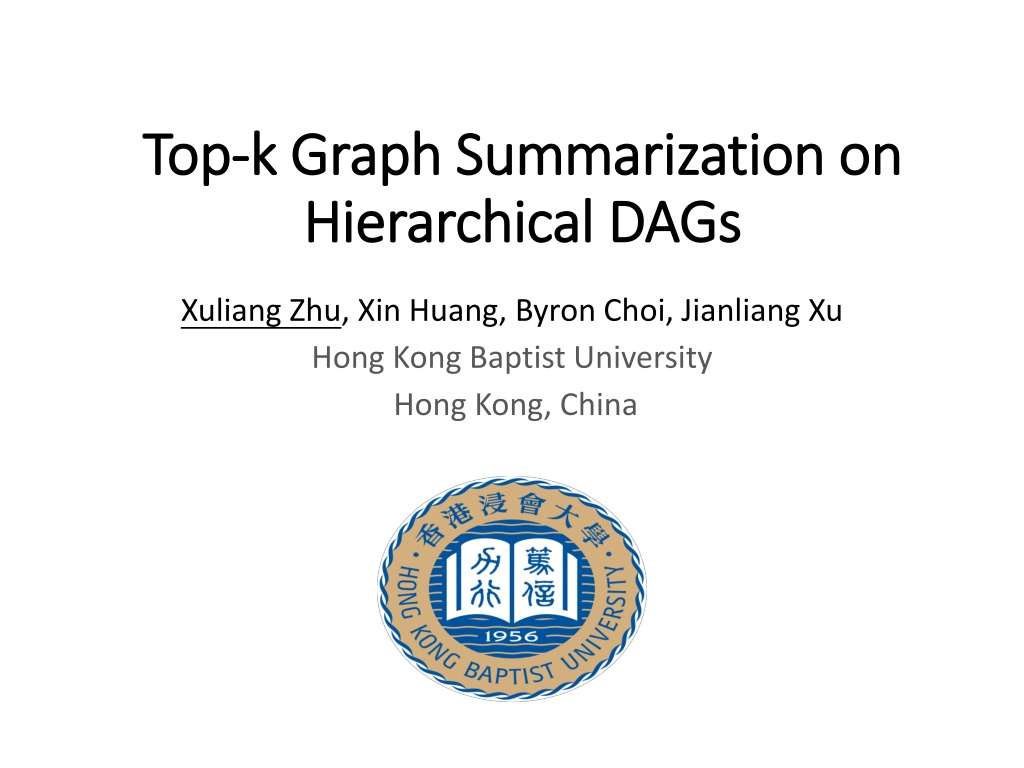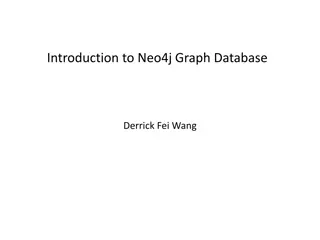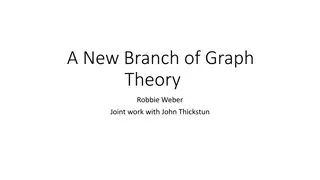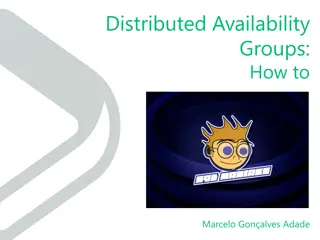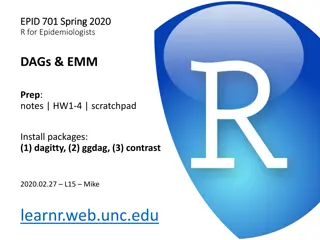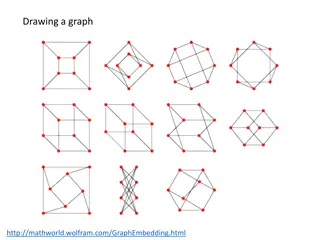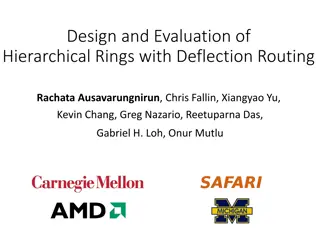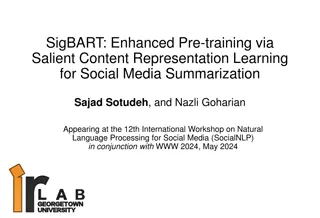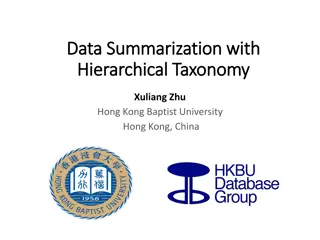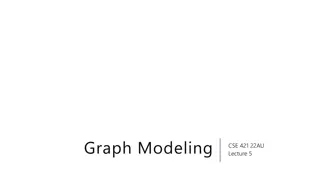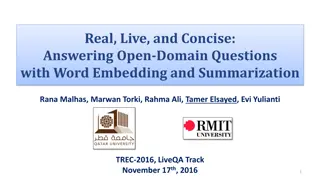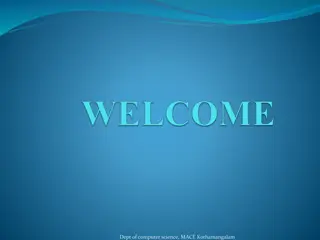Graph Summarization on Hierarchical DAGs
Explore top-k graph summarization techniques on Hierarchical Directed Acyclic Graphs (DAGs) like Disease Ontology, ImageNet, and Wikipedia Categories. Understand motivations for summarization, related works, and the kDAG-Problem. Discover algorithms, experiments, and conclusions for efficient graph summarization in complex structures.
Download Presentation

Please find below an Image/Link to download the presentation.
The content on the website is provided AS IS for your information and personal use only. It may not be sold, licensed, or shared on other websites without obtaining consent from the author.If you encounter any issues during the download, it is possible that the publisher has removed the file from their server.
You are allowed to download the files provided on this website for personal or commercial use, subject to the condition that they are used lawfully. All files are the property of their respective owners.
The content on the website is provided AS IS for your information and personal use only. It may not be sold, licensed, or shared on other websites without obtaining consent from the author.
E N D
Presentation Transcript
Top Top- -k Graph Summarization on k Graph Summarization on Hierarchical DAGs Hierarchical DAGs Xuliang Zhu, Xin Huang, Byron Choi, Jianliang Xu Hong Kong Baptist University Hong Kong, China
Outlines Motivations Related Work KDAG-Problem Algorithms Experiments Conclusions
Motivations Hierarchical DAGs are everywhere (e.g. Disease Ontology, ImageNet, Wikipedia Categories) Node Weights Disease Ontology The occurrences of diseases ImageNet The number of pictures Wikipedia Categories The views under the categories Disease Ontology ImageNet Wikipedia Categories
Motivations Top-k summarization Massive terminologies and complex structures Difficult to understand or visualize An example (k=4) disease: general concept COVID-19: the most important disease cancer & flu: two categories of multiple diseases with large weights Disease Ontology Top-4 Summarization
Related Work Aggregate method [X Jing et al. 2014] Select top-k vertices with maximum aggregate value. Lack diversity Disease Ontology GVDO Model Tree Aggregate method Our method
Related Work Graph summarization Graph stream summarization[X Gou et al. ICDE 19] RDF graph summarization [S Cebiric et al. PVLDB 15] Summarization for keyword search [G Fakas et al. SIGMOD 15] Top-k diversification Top-k maximum clique [L Yuan et al. VLDBJ 16] Top-k diversified subgraph [Z Yang et al. SIGMOD 16]
Outlines Motivations Related Work KDAG-Problem Algorithms Experiments Conclusions
kDAG-Problem Summary Score Here, S is the selected set, V is the set of all vertices and feq(u) is the weight of vertex u. The score is determined by the weight and distance from the selected vertices. KDAG-problem Find the set
kDAG-Problem Analysis Diversity The selected vertices are not similar. Small Scale The size of selected vertices is small. Large Coverage The selected vertices can reach many important vertices. High Correlation The representative correlation of selected vertices to an important vertex is high. Our kDAG-Problem is NP-hard Reduction from 3-SAT problem
Outlines Motivations Related Work KDAG-Problem Algorithms Experiments Conclusions
Greedy+ 37 1 1 1 Marginal Gain 39 46 24 0 2 3 2 3 L Add maximum marginal gain into S greedily. 4 5 6 6 7 6 4 5 6 6 7 6 42 18 42 18 Marginal Gain Running Example
Greedy+ 37 1 1 1 Marginal Gain 39 46 24 0 2 3 2 3 L Add maximum marginal gain into S greedily. 4 5 6 6 7 6 4 5 6 6 7 6 42 18 42 18 Marginal Gain Running Example
Greedy+ 37 1 1 1 Marginal Gain 39 24 0 2 3 2 3 L Add maximum marginal gain into S greedily. 4 5 6 6 7 6 4 5 6 6 7 6 42 18 42 18 Marginal Gain Running Example
Greedy+ 37 1 1 1 Marginal Gain 39 24 0 2 3 2 3 L Add maximum marginal gain into S greedily. 4 5 6 6 7 6 4 5 6 6 7 6 21 18 42 18 Marginal Gain Running Example
Greedy+ 37 1 1 1 Marginal Gain 14 24 0 2 3 2 3 L Add maximum marginal gain into S greedily. 4 5 6 6 7 6 4 5 6 6 7 6 21 18 42 18 Marginal Gain Running Example
Greedy+ 1 1 1 1 Marginal Gain 14 24 0 2 3 2 3 L Add maximum marginal gain into S greedily. 4 5 6 6 7 6 4 5 6 6 7 6 21 18 42 18 Marginal Gain Running Example
Greedy+ Monotone Submodular (1 1/e)-approximation guarantee
EXT-Greedy 1 1 Extract subtree based on greedy+ answer. 24 0 2 3 Apply optimal method[1] on the subtree. 4 5 6 6 7 6 42 18 Running Example [1] Ontology-based Graph Visualization for Summarized View. X Zhu et al. 2020. arXiv:arXiv:2008.03053
EXT-Greedy 1 1 Extract subtree based on greedy+ answer. 24 0 2 3 Apply optimal method[1] on the subtree. 4 5 6 6 7 6 42 18 Greedy+ answer [1] Ontology-based Graph Visualization for Summarized View. X Zhu et al. 2020. arXiv:arXiv:2008.03053
EXT-Greedy 1 1 Extract subtree based on greedy+ answer. 24 0 2 3 Apply optimal method[1] on the subtree. 4 5 6 6 7 6 42 18 Subtree extraction [1] Ontology-based Graph Visualization for Summarized View. X Zhu et al. 2020. arXiv:arXiv:2008.03053
EXT-Greedy 1 1 Extract subtree based on greedy+ answer. 24 0 2 3 Apply optimal method[1] on the subtree. 4 5 6 6 7 6 42 18 Optimal solution in subtree [1] Ontology-based Graph Visualization for Summarized View. X Zhu et al. 2020. arXiv:arXiv:2008.03053
EXT-Greedy 1 1 Extract subtree based on greedy+ answer. 24 0 2 3 Apply optimal method[1] on the subtree. 4 5 6 6 7 6 42 18 Optimal solution in the original DAG [1] Ontology-based Graph Visualization for Summarized View. X Zhu et al. 2020. arXiv:arXiv:2008.03053
K-PCGS 22 22 22 1 1 Compress DAG Compress the DAG into a new graph by removing useless vertices. 12 24 0 0 24 0 2 3 2 3 4 5 6 7 4 5 0 6 6 7 6 Pruning Candidates Prune the vertices from candidateswhose upper bound is smaller than the top-k lower bound. 3 6 3 6 0 0 0 0 0 8 30 60 8 60 Compressed DAG Pruned Candidates (Black) Candidates (Blue) Lower Bound (Green) Upper Bound (Red)
K-PCGS 22 22 22 1 1 Compress DAG Compress the DAG into a new graph by removing useless vertices. 12 24 0 0 24 0 2 3 2 3 4 6 7 4 6 6 7 6 Pruning Candidates Prune the vertices from candidateswhose upper bound is smaller than the top-k lower bound. 3 6 3 6 0 0 0 8 30 60 8 60 Compressed DAG Pruned Candidates (Black) Candidates (Blue) Lower Bound (Green) Upper Bound (Red)
K-PCGS 22 22 22 1 1 Compress DAG Compress the DAG into a new graph by removing useless vertices. 14 30 0 0 (24, 12) 0 2 3 2 3 4 4 Pruning Candidates Prune the vertices from candidateswhose upper bound is smaller than the top-k lower bound. 0 0 0 8 30 60 8 60 Compressed DAG Pruned Candidates (Black) Candidates (Blue) Lower Bound (Green) Upper Bound (Red)
K-PCGS 22 22 22 1 1 Compress DAG Compress the DAG into a new graph by removing useless vertices. 14 30 0 20 (24, 12) 0 2 3 2 3 4 4 Pruning Candidates Prune the vertices from candidateswhose upper bound is smaller than the top-k lower bound. 0 0 0 8 30 60 8 60 Compressed DAG Pruned Candidates (Black) Candidates (Blue) Lower Bound (Green) Upper Bound (Red)
K-PCGS 22 53 22 1 1 Compress DAG Compress the DAG into a new graph by removing useless vertices. 14 30 0 20 (24, 12) 0 2 3 2 3 4 4 Pruning Candidates Prune the vertices from candidateswhose upper bound is smaller than the top-k lower bound. 0 0 0 8 30 60 8 60 Compressed DAG Pruned Candidates (Black) Candidates (Blue) Lower Bound (Green) Upper Bound (Red)
Complexity Comparison Method Greedy+ EXT-Greedy k-PCGS Time Complexity O(nkm) O(nkm+nk3h) O(mh + nlogn + k|C|m ) Space Complexity O(m) O(nk2h) O(m) Here, n is the size of vertices, m is the size of edges, h is the height of DAG (length of longest shortest path). |C| is smaller than n and m is smaller than m.
Outlines Motivations Related Work KDAG-Problem Algorithms Experiments Conclusions
Datasets Dataset Hierarchical DAG Weight n m LATT Medical Entity Dictionary Number of queries 4,226 8,190 from patients LNUR Medical Entity Dictionary Number of queries 4,226 8,190 from nurses ANIM Anime" catalog in Wikipedia Number of views 15,135 24,498 IMAGE YAGO3 ImageNet (WordNet) Wikipedia + WordNet Number of pictures Synthetic 73,298 5,699,254 74,732 17,512,754 UCI Social Network Only for efficiency test Synthetic 58,790,783 92,208,196
Evaluation metrics Summary Score Average Distance 1-hop Weighted Coverage
Methods compared FEQ [X Jing et al. 2014] Select k nodes with the highest weight. CAGG [X Jing et al. 2014] Aggregate method with a contribution ratio. LASP [G Fakas et al. SIGMOD 15] Add the largest averaged score path greedily.
Effectiveness Evaluations Average Distance of different models. Our kDAG model outperforms state-of-the-art models with the smallest average distance.
Efficiency Evaluations Efficiency evaluation of Greedy+, EXT-Greedy, k-PCGS and CAGG methods on ImageNet. The k-PCGS runs fastest among all methods and EXT-Greedy is the slowest.
Efficiency Evaluations The size of candidates The k-PCGSreduces at least 90% candidates in the worst case and more than 99% in most cases.
Outlines Motivations Related Work KDAG-Problem Algorithms Experiments Conclusions
Conclusions We study the top-k graph summarization problem on large hierarchical DAGs. We propose a novel model of kDAG-problem and proof its NP-hardness. We develop three algorithms to tackle kDAG-problem: Greedy+: A baseline greedy method. EXT-Greedy: A more effective method. k-PCGS: A more efficient method.
Thank you for watching! Contact us: csxlzhu@comp.hkbu.edu.hk
